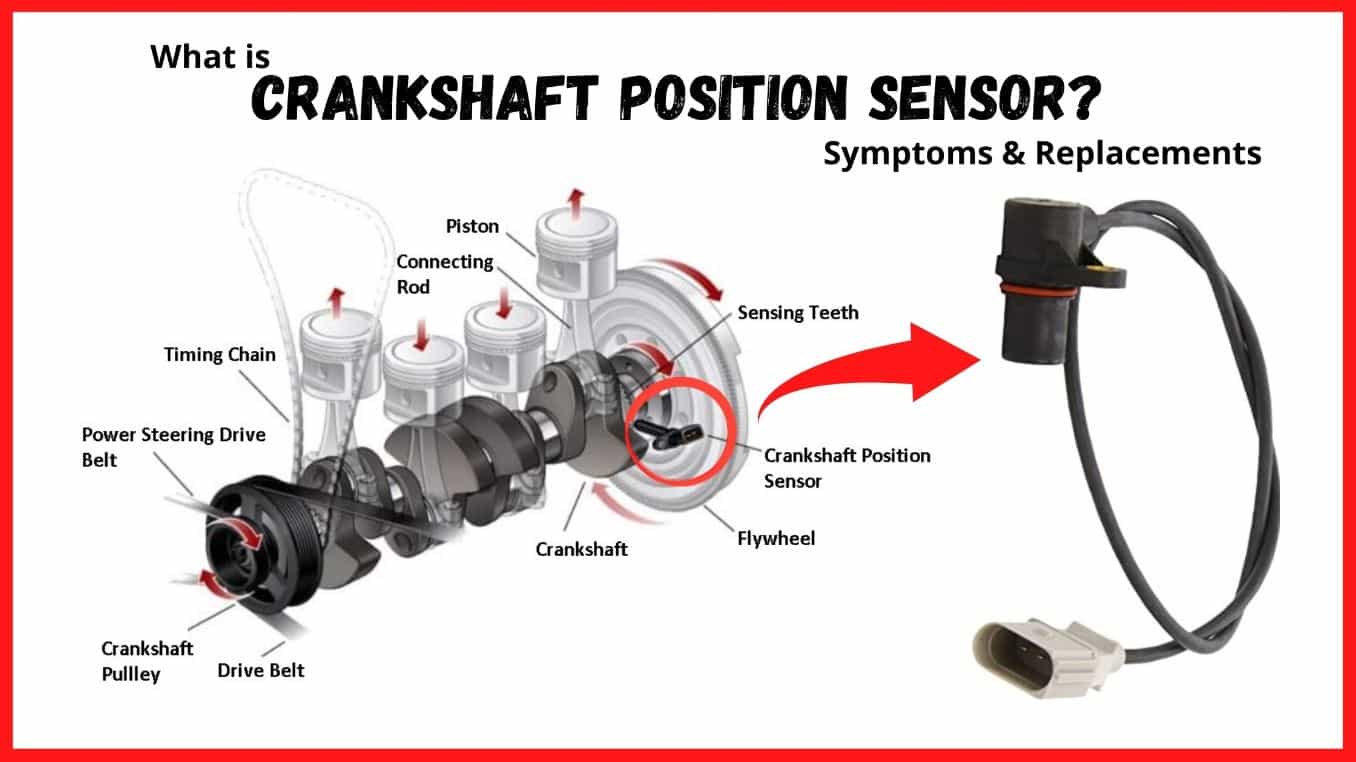Table of Contents
Crankshaft Position Sensor: Definition and Importance
The crankshaft position sensor (CKP sensor) is a vital component in modern internal combustion engines, playing a crucial role in ensuring optimal engine performance and efficiency. This sensor is responsible for monitoring the position and rotational speed of the crankshaft, relaying this information to the engine control unit (ECU). By providing real-time data, the CKP sensor helps the ECU determine the precise timing for fuel injection and ignition, which are critical processes for maintaining engine efficiency and power output. Typically located near the crankshaft, either on the engine block or the timing cover, the CKP sensor employs various technologies, such as magnetic or Hall effect sensors, to detect the crankshaft’s position. As a result, it directly influences the engine’s overall operation and functionality. A well-functioning crankshaft position sensor is essential for smooth engine operation; if it malfunctions, it can lead to a myriad of problems, including misfiring, difficulty starting the engine, and reduced fuel efficiency. The sensor’s readings enable the ECU to make instantaneous adjustments to the fuel-air mixture and ignition timing, optimizing performance under different driving conditions.
The importance of the crankshaft position sensor cannot be overstated. It is a key player in the engine management system, directly affecting performance metrics such as power delivery, acceleration, and fuel consumption. When the sensor functions correctly, it ensures that the engine runs smoothly and efficiently, helping to maximize fuel economy while minimizing emissions. Conversely, a faulty crankshaft position sensor can trigger various symptoms that can severely affect the engine’s operation. Drivers may experience engine misfiring, which can result in a loss of power and responsiveness, making it difficult to accelerate or maintain speed. Additionally, difficulty starting the engine can occur, as the incorrect timing information can prevent the ignition system from firing at the right moment. In many cases, the “Check Engine” light will illuminate on the dashboard, indicating a potential issue related to the crankshaft position sensor, often accompanied by diagnostic trouble codes that can be read with an OBD-II scanner.
Moreover, a malfunctioning CKP sensor can cause unusual engine behavior, such as stalling or erratic idling. These issues can be particularly problematic, as they may occur unexpectedly while driving, posing a safety risk to the driver and passengers. Reduced fuel efficiency is another common symptom, as the engine may struggle to operate within its optimal parameters, leading to increased fuel consumption. When the sensor fails to provide accurate readings, the ECU may inject fuel incorrectly, resulting in poor combustion efficiency and higher emissions.
Overall, understanding the crankshaft position sensor’s function and the importance it holds in engine performance is crucial for vehicle maintenance. Regular diagnostics and timely replacement of this component, if faulty, can save drivers from extensive repair costs and ensure the vehicle operates at its best. In summary, the crankshaft position sensor is indispensable for efficient engine management, and its proper functioning is paramount for maximizing performance, enhancing fuel efficiency, and ensuring a safe and enjoyable driving experience.
Crankshaft Position Sensor Symptoms

The crankshaft position sensor (CKP sensor) is an essential component in a vehicle’s engine management system, and its failure can lead to several noticeable symptoms that significantly affect vehicle performance. Understanding these symptoms can help drivers identify potential issues early, preventing more severe problems down the road. One of the most common symptoms of a faulty crankshaft position sensor is engine misfiring. This occurs when the engine fails to fire consistently, leading to a rough running condition, reduced power, and a noticeable loss of acceleration. Engine misfires are often caused by incorrect timing in the fuel injection or ignition process, which the CKP sensor directly influences. If the sensor is not sending accurate position information to the engine control unit (ECU), the ignition system may spark at the wrong time, causing the engine to misfire.
Another significant symptom is difficulty starting the engine. When the crankshaft position sensor malfunctions, it can prevent the ECU from determining the correct timing for ignition. As a result, the engine may struggle to start or may not start at all. This issue can be particularly frustrating for drivers, as it can occur unexpectedly and may lead to being stranded if the vehicle does not start. In some cases, the engine may turn over but fail to fire, indicating that the sensor may not be providing the necessary data for the ignition system to function correctly.
The Check Engine Light (CEL) is another telltale sign of a potential crankshaft position sensor issue. When this light illuminates, it indicates that the ECU has detected a problem within the engine management system, often accompanied by specific diagnostic trouble codes (DTCs). These codes can point directly to the crankshaft position sensor or indicate related issues, helping technicians diagnose the problem more accurately. It’s essential for drivers to pay attention to this warning light and have the vehicle scanned for codes to identify the underlying issue promptly.
Additionally, drivers may notice unusual engine behavior, which can manifest as erratic idling or stalling. A malfunctioning CKP sensor can lead to fluctuating engine speeds, making the engine idle inconsistently or even stall unexpectedly. This erratic behavior not only affects comfort and drivability but can also pose safety risks, particularly if the engine stalls while driving. Another critical symptom is reduced fuel efficiency. When the CKP sensor fails to provide accurate timing data, the ECU may struggle to maintain optimal fuel-air mixtures, resulting in poor combustion efficiency. This inefficiency can lead to increased fuel consumption, which directly impacts the vehicle’s economy and leads to higher operating costs over time.
Lastly, drivers might experience inconsistent engine performance, characterized by fluctuations in power and responsiveness. A faulty crankshaft position sensor can cause the engine to hesitate during acceleration or exhibit unpredictable behavior during operation. These performance issues not only make driving less enjoyable but can also hinder the vehicle’s overall safety. Recognizing these symptoms early is crucial for addressing crankshaft position sensor problems before they escalate into more severe engine issues. Regular maintenance and diagnostic checks can help identify sensor-related problems, ensuring the engine operates efficiently and reliably. In conclusion, being aware of the symptoms associated with a faulty crankshaft position sensor can empower drivers to take timely action, thereby preserving the integrity and performance of their vehicle.
Crankshaft Position Sensor Location

Knowing the location of the crankshaft position sensor (CKP sensor) is crucial for effective troubleshooting and replacement, as it is a critical component that directly affects engine performance. The CKP sensor monitors the position and rotational speed of the crankshaft, relaying vital information to the engine control unit (ECU) to optimize ignition timing and fuel injection. If the sensor malfunctions or becomes damaged, it can lead to various engine issues, making its prompt identification and replacement essential. Understanding where to find the crankshaft position sensor in different vehicle types can save time and effort when diagnosing engine problems.
For front-wheel drive vehicles, the crankshaft position sensor is typically located near the engine block or the timing cover. This placement allows for easy access to the sensor while also enabling it to accurately monitor the crankshaft’s position as it rotates. In many front-wheel drive models, the sensor is mounted on the side of the engine block, close to the crankshaft pulley, which allows it to detect the rotational movement effectively. This convenient location is designed to facilitate quicker repairs, but the exact positioning can vary slightly between different makes and models, making it vital to consult the vehicle’s service manual for precise details.
In contrast, rear-wheel drive vehicles often have the crankshaft position sensor positioned along the transmission or bell housing. This placement is necessary because the crankshaft extends through the transmission to connect to the drive shaft. In these vehicles, the CKP sensor may be located at the back of the engine or near the transmission, allowing it to monitor the crankshaft effectively. While this location serves the same fundamental purpose, accessing the sensor may be more challenging, particularly in cramped engine bays or if there are components obstructing visibility.
Additionally, the location of the crankshaft position sensor can vary based on the engine type, such as V6 or V8 configurations. In V6 engines, the sensor is often placed at the front of the engine, similar to front-wheel drive vehicles, but can also be found at the rear, depending on the specific design. In V8 engines, the CKP sensor may be located on either side of the engine, usually near the crankshaft pulley or flywheel. The variation in sensor placement is influenced by factors like the engine’s design, manufacturer specifications, and the vehicle’s layout.
To assist in locating the crankshaft position sensor, visual aids such as diagrams or images can be incredibly helpful. Service manuals often provide detailed illustrations that pinpoint the CKP sensor’s location within the engine compartment. These resources can guide mechanics and DIY enthusiasts, enabling them to quickly identify and access the sensor without unnecessary guesswork. Furthermore, online forums and manufacturer websites may also offer helpful images and user-generated content that illustrate sensor locations across various vehicle makes and models.
In summary, understanding the location of the crankshaft position sensor is essential for effective troubleshooting and replacement. Whether in front-wheel or rear-wheel drive vehicles, the sensor’s position can significantly influence repair times and ease of access. Being aware of the variations in sensor placement across different engine types can help vehicle owners and technicians quickly diagnose and address issues related to the CKP sensor. Ultimately, a well-informed approach to locating this critical component can lead to more efficient maintenance and enhanced engine performance.
Testing and Diagnosis of the Crankshaft Position Sensor

Testing and diagnosing a crankshaft position sensor (CKP sensor) is crucial for maintaining optimal engine performance, as a malfunctioning sensor can lead to a variety of issues, including misfiring, difficulty starting, and reduced fuel efficiency. To effectively diagnose a faulty CKP sensor, several tools and methods are typically employed. First and foremost, having an OBD-II scanner is essential for modern vehicles, as it allows technicians and DIY enthusiasts to retrieve diagnostic trouble codes (DTCs) from the vehicle’s onboard computer. When the check engine light illuminates on the dashboard, an OBD-II scanner can be used to identify specific error codes related to the CKP sensor or other engine management components. These codes provide valuable insights into potential malfunctions and help pinpoint whether the CKP sensor is indeed the source of the problem or if other related components are involved.
Once the error codes are retrieved, the next step in diagnosing the crankshaft position sensor involves multimeter testing. This method requires a digital multimeter, a versatile tool that measures voltage, resistance, and current. To test the CKP sensor with a multimeter, the technician must first locate the sensor and disconnect its electrical connector. By setting the multimeter to the appropriate setting for resistance (ohms) or voltage, the technician can measure the output signals of the sensor while the engine is cranking. A functioning CKP sensor should produce a specific range of voltage or resistance values, depending on the vehicle’s specifications. If the readings fall outside the expected range, it indicates that the sensor may be faulty and requires replacement.
In addition to using an OBD-II scanner and multimeter, performing a physical inspection of the CKP sensor is another crucial step in the diagnostic process. This involves visually examining the sensor for signs of damage, wear, or corrosion. The technician should check the wiring and connectors associated with the CKP sensor, ensuring they are secure and free from fraying or shorts. A damaged or disconnected wiring harness can mimic a faulty sensor, so this step is critical in ruling out potential issues. Additionally, inspecting the sensor’s mounting location can reveal if it has been jarred or misaligned, which could affect its performance.
While DIY methods can be effective for diagnosing a crankshaft position sensor, there are instances when seeking professional help is advisable. Professional mechanics possess specialized diagnostic equipment and experience that can expedite the testing process and accurately diagnose complex issues. They also have access to updated technical service bulletins and manufacturer specifications, which can be beneficial when troubleshooting more obscure problems. For individuals who may not be comfortable performing tests or working with electrical components, consulting a professional mechanic can provide peace of mind and ensure that the vehicle is serviced correctly.
In conclusion, testing and diagnosing a crankshaft position sensor involves a combination of tools and techniques, including OBD-II scanners, multimeter testing, and physical inspections. By following these steps, vehicle owners can identify potential issues related to the CKP sensor and take the necessary steps to address them. While many individuals may choose to tackle these diagnostic tasks themselves, the option for professional help is always available for those who prefer a more thorough and efficient approach. Ultimately, understanding how to test and diagnose the CKP sensor can lead to timely repairs, enhanced engine performance, and improved vehicle reliability.
Conclusion: The Importance of the Crankshaft Position Sensor
In summary, the crankshaft position sensor (CKP sensor) is a vital component of modern internal combustion engines, playing an indispensable role in ensuring optimal performance and efficiency. This small but crucial device monitors the position and rotational speed of the crankshaft, providing the engine control unit (ECU) with real-time data necessary for adjusting fuel injection and ignition timing. A properly functioning CKP sensor ensures that the engine runs smoothly, delivers power efficiently, and maintains fuel economy while minimizing harmful emissions. Given its critical role in the engine management system, understanding the importance of the crankshaft position sensor cannot be overstated. When the sensor fails or begins to malfunction, it can trigger a series of symptoms that significantly affect vehicle performance, including engine misfires, difficulty starting, erratic idling, and reduced fuel efficiency. These symptoms can not only lead to an unpleasant driving experience but can also compromise the safety and reliability of the vehicle.
Addressing these symptoms promptly is essential for preventing further engine issues and avoiding costly repairs. When drivers notice signs of a failing crankshaft position sensor, such as the check engine light illuminating on the dashboard or experiencing difficulties in engine operation, it is crucial to take action quickly. Ignoring these symptoms may lead to more severe problems, including damage to other engine components, resulting in extensive repairs that could have been avoided with timely intervention. Regular maintenance checks and diagnostics are vital to identifying potential issues early, allowing for preventative measures to be taken before they escalate.
Moreover, understanding how to test and diagnose the crankshaft position sensor empowers vehicle owners to take an active role in their car’s maintenance. Whether through DIY diagnostics using an OBD-II scanner and multimeter or seeking the expertise of professional mechanics, recognizing the signs of a failing CKP sensor can lead to quicker resolutions and improved engine performance. By staying informed about the condition of the crankshaft position sensor and acting on any warning signs, drivers can ensure their vehicles remain in optimal working condition, enhancing both performance and safety.
Ultimately, the crankshaft position sensor is not just a minor component; it is a key player in the overall functionality of the engine. Its proper operation is essential for achieving the best possible driving experience, maintaining fuel efficiency, and ensuring compliance with emissions regulations. As vehicles become increasingly sophisticated, the importance of monitoring and maintaining critical components like the CKP sensor cannot be overlooked. In conclusion, prioritizing the health of the crankshaft position sensor and addressing symptoms promptly is essential for preserving the longevity and reliability of the engine, ultimately leading to a safer and more enjoyable driving experience. Vehicle owners are encouraged to remain vigilant and proactive in maintaining this crucial component, as it plays a significant role in the overall performance and efficiency of their vehicles.
Additional Resources for Crankshaft Position Sensor Awareness
To further enhance your understanding of the crankshaft position sensor (CKP sensor) and its significance in vehicle performance, there are several valuable resources available for additional reading. These resources can provide deeper insights into the mechanics of the sensor, its functioning, and troubleshooting methods. One excellent starting point is automotive repair websites and forums where enthusiasts and professionals share their knowledge and experiences related to crankshaft position sensors. Websites like AutoZone and Advance Auto Parts offer detailed guides and articles about CKP sensors, including common symptoms of failure, testing procedures, and replacement tips. These resources often include step-by-step instructions, diagrams, and videos that can be incredibly helpful for both seasoned mechanics and DIY enthusiasts looking to diagnose or replace their CKP sensors effectively. Furthermore, reputable automotive repair manuals, such as those published by Haynes or Chilton, can serve as comprehensive references, providing extensive information on various vehicle models, including specifications, troubleshooting techniques, and repair guidelines specific to the crankshaft position sensor.
In addition to online articles and repair manuals, you may find it beneficial to explore educational content available through platforms like YouTube. Many automotive professionals share tutorials and walkthroughs on diagnosing and replacing crankshaft position sensors, providing visual guidance that can enhance your understanding of the sensor’s location, testing methods, and installation procedures. These videos can also highlight common mistakes to avoid during replacement, ensuring a smoother repair experience.
For those who prefer professional assistance, finding a reputable repair shop or mechanic specializing in sensor replacements is crucial. Local automotive repair shops with experienced technicians can provide the expertise needed to address CKP sensor issues effectively. It is advisable to seek out shops that have good customer reviews and ratings, which can often be found on platforms like Google Reviews or Yelp. Additionally, consider looking for repair shops that are certified by automotive organizations, such as the National Institute for Automotive Service Excellence (ASE). ASE-certified mechanics have demonstrated their proficiency in various automotive repair areas, including engine management systems, making them well-suited to handle CKP sensor diagnostics and replacements.
Another excellent resource for finding qualified mechanics is the AAA (American Automobile Association). They provide a directory of approved repair facilities that meet their high standards for quality and customer service. This can be a reliable way to find trustworthy professionals in your area who can assist with crankshaft position sensor issues and other automotive repairs.
In summary, educating yourself about the crankshaft position sensor through various resources can significantly enhance your ability to identify problems and understand its impact on vehicle performance. Utilizing online articles, repair manuals, and instructional videos can provide valuable insights, while seeking professional assistance from reputable repair shops ensures that any issues are addressed effectively and efficiently. By leveraging these resources, you can gain a deeper understanding of your vehicle’s CKP sensor, allowing for timely maintenance and repairs that contribute to the overall longevity and reliability of your engine.
FAQS
What is a crankshaft position sensor, and what does it do? The crankshaft position sensor (CKP sensor) monitors the position and rotational speed of the crankshaft, providing critical data to the engine control unit (ECU) for optimizing ignition timing and fuel injection.
What are the common symptoms of a faulty crankshaft position sensor? Common symptoms include engine misfiring, difficulty starting, activation of the check engine light, unusual engine behavior (such as stalling), reduced fuel efficiency, and inconsistent engine performance.
How can a faulty crankshaft position sensor affect engine performance? A malfunctioning CKP sensor can lead to incorrect ignition timing and fuel injection, resulting in poor acceleration, stalling, and reduced fuel economy, ultimately compromising the vehicle’s performance and reliability.
Where is the crankshaft position sensor typically located? The CKP sensor is usually found near the engine block or timing cover in front-wheel drive vehicles, while in rear-wheel drive vehicles, it may be positioned along the transmission or bell housing. The exact location can vary based on the vehicle’s engine type (e.g., V6 or V8).
How can I test a crankshaft position sensor? Testing can be done using an OBD-II scanner to retrieve diagnostic trouble codes, a multimeter to measure voltage or resistance, and a physical inspection to check for damage or loose connections.
What tools do I need to diagnose a crankshaft position sensor? Essential tools include an OBD-II scanner, a digital multimeter, basic hand tools for accessing the sensor, and potentially a repair manual or online resources for reference.
Can I replace the crankshaft position sensor myself, or should I seek professional help? While experienced DIY enthusiasts can often replace the CKP sensor themselves, it may be beneficial to consult a professional mechanic, especially if you are unfamiliar with engine diagnostics and repairs.
What are the potential error codes associated with a faulty crankshaft position sensor? Common error codes related to the CKP sensor include P0335 (crankshaft position sensor A circuit), P0336 (crankshaft position sensor A circuit range/performance problem), and P0337 (crankshaft position sensor A circuit low).
How does a faulty crankshaft position sensor impact fuel efficiency? A faulty sensor can cause the ECU to miscalculate the timing for fuel injection, leading to incomplete combustion and increased fuel consumption, which ultimately reduces fuel efficiency.
How often should I have my crankshaft position sensor checked or replaced? While there is no specific schedule for CKP sensor replacement, it’s advisable to have it inspected during routine maintenance or if you notice any symptoms of malfunction. Regular checks can help prevent more significant engine issues down the road.






